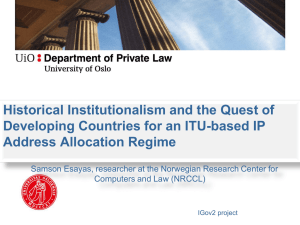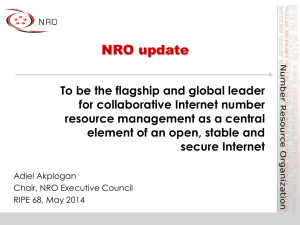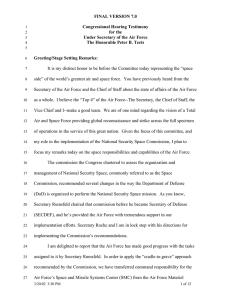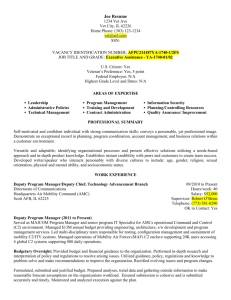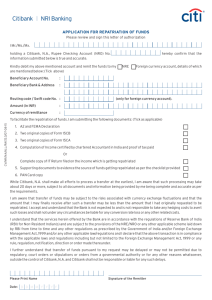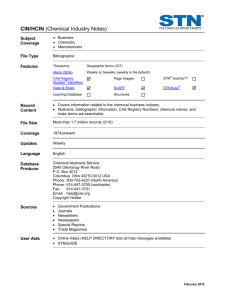Statement for the Record by Dr. Donald M. Kerr
advertisement
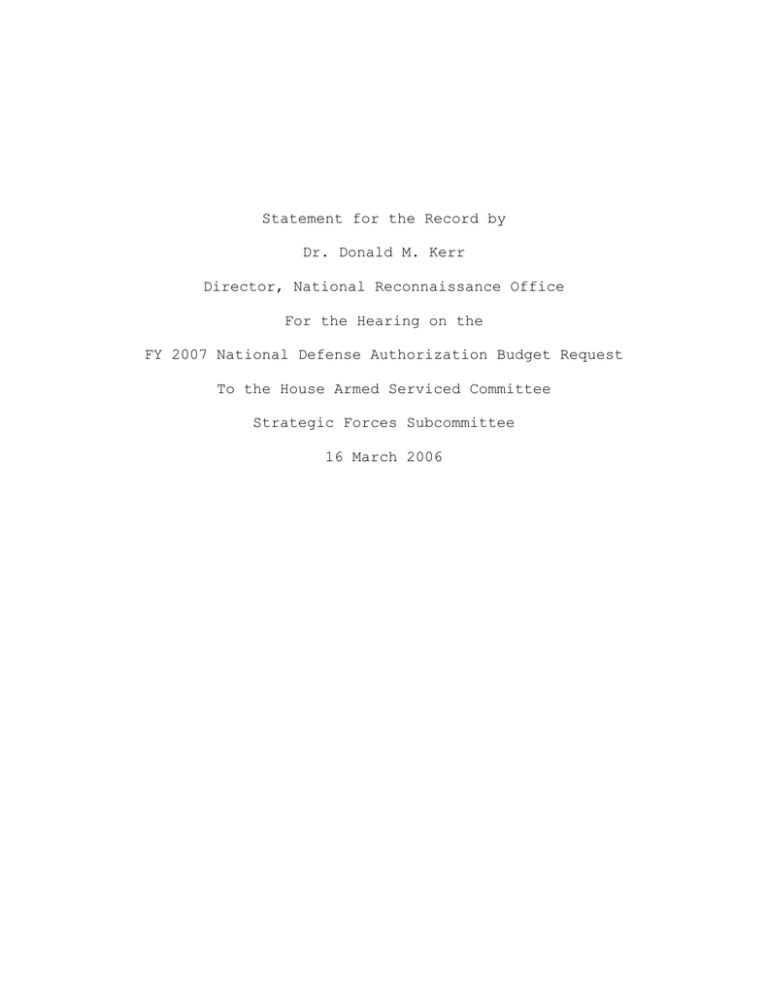
Statement for the Record by Dr. Donald M. Kerr Director, National Reconnaissance Office For the Hearing on the FY 2007 National Defense Authorization Budget Request To the House Armed Serviced Committee Strategic Forces Subcommittee 16 March 2006 Introduction Thank you for the opportunity to come before your subcommittee to talk about the National Reconnaissance Office (NRO), its future, the relationship between the NRO and the larger national security space establishment, and the very important role the NRO plays on a daily basis in direct and indirect support to the warfighter. Unfortunately, my enthusiasm for what we do must be tempered today by the fact that this is an unclassified hearing. While it is a privilege to be able to share with you some insight into the NRO and what we do for our nation, I will not be able to go into detail and I ask that you keep this in mind when we proceed to your questions. I would welcome the opportunity to meet with you separately to discuss the NRO in greater depth and my plans for its future. Better yet, please consider a visit to the NRO to get a first-hand look at what we do. The Future of the NRO Last July the Secretary of Defense (SECDEF), with the concurrence of the Director of National Intelligence, appointed me as the 15th Director of the NRO. While the job was new, my familiarity with the NRO and its programs was not. In 2001, I was charged by the SECDEF and then Director of Central Intelligence to lead a panel to assess how innovative remote sensing technologies could support future national security needs. 2 The panel findings and recommendations, published in October 2001, remain largely valid today, but the urgency is greater than ever. Today’s national security depends more than ever on capabilities that can only be delivered from space; the only place we can achieve the degree of global situational awareness needed by the Intelligence Community (IC) and the Department of Defense (DoD). In order to meet these needs, the NRO must develop systems with the ability to cue other systems and users, and at the same time provide focused collection anytime and anywhere. Because today’s users are fundamentally different, they are no longer satisfied with data; they are rightly demanding information tailored to their interests and problems, a by-product of our fast-paced world, where timely decisions impact the lives of our warfighters and the security of our nation. In order to meet these demanding needs the NRO will pursue two strategic goals: - Be the foundation for global situational awareness and; - Provide intelligence within timelines responsive to user needs. Meeting these goals will require the NRO to plan, develop, and manage an integrated architecture focused on creating intelligence value for our users. An important aspect will be the use of the latest technologies on the ground to realize and take advantage of new capabilities for existing overhead systems. Our ground systems will be essential enablers for the cueing, tip-off, and information fusion capabilities required to 3 build comprehensive understanding of our adversaries’ actions and intentions. In fact, because of the leverage we can achieve on the ground, ground-based capabilities will be as critical as overhead collection in meeting the need for actionable intelligence. The NRO cannot do this without the strong partnership with our key stakeholders and mission partners. Our relationships with the military services, USSTRATCOM, National Security Agency (NSA), National Geospatial-Intelligence Agency (NGA), Homeland Security, and others are critical in helping us meet our worldwide intelligence, surveillance, and reconnaissance responsibilities. Certainly, one of our most important stakeholders is the U.S. Congress, and I ask your support in implementing the changes required to keep pace with today’s threats. The NRO and National Security Space One topic of particular interest today is the nature of the relationship between the NRO and the DoD--in particular the Air Force space community. The NRO and the Air Force have a cooperative and collaborative partnership which is critical to our mutual success. We leverage each other’s expertise and resources to meet each of our unique mission objectives. However, space is our common operating environment, not our mission. Even so, the NRO and the Air Force have intersecting interests in areas such as personnel, mission assurance standards for spacecraft, assured access to space through launch 4 services, spacecraft development, and providing ways to best support the warfighter. I am excited to say we have a long history of successful collaboration with the Air Force and I expect it to strengthen. - Manning. the IC. Some areas of success include: The NRO is a joint venture between the DoD and The NRO could not do what it does today without the commitment of all the military services and their remarkably talented and extremely capable personnel. The Air Force provides nearly half of the NRO’s workforce. The Navy, Army, and Marines also provide technical and support staff. We are actively engaged with our Service partners, especially the Air Force, in ensuring that we have a robust, dedicated, career space cadre for the national security space community. - Mission Assurance. Satellites are expensive and complex, operating in a very extreme environment. Because of this, they require unique engineering, design, and testing considerations to meet the mission requirement over the life of the spacecraft. Improving on mission assurance is a concern of the NRO and an area in which the NRO is strengthening its collaboration with the Air Force. The NRO is in close coordination with the Air Force on common spacecraft issues, such as parts, materials, technologies, standards, and acquisition policies. - Launch. The NRO collaborates with the Air Force on launch vehicle acquisitions, as well as launch base operations and infrastructure to support NRO launches. Recognizing the lack of a robust commercial market that meets our requirements, 5 the NRO and Air Force have worked shoulder-to-shoulder over the past two years to develop a strategy for future launch vehicle acquisitions. Additionally, the NRO relies on Air Force aircraft and crews to transport our spacecraft from the factory to the launch base. - Spacecraft/Sensor Integration. The NRO has a longstanding and successful history with the Air Force as well as other military services of hosting payloads that help meet system and service requirements. Maintaining this flexibility is an effective way for us to reduce the cost of placing capabilities in space, particularly for demonstration payloads. These are but a few examples of our close partnerships and their importance. However, in the end, what is truly important is how we ultimately serve our customers. Of particular importance today is what we do for the warfighter. Support to Military Operations For over the past decade, one of the real success stories at the NRO has been the aggressive path we have taken to find new and innovative ways to support our men and women in uniform. This is an outgrowth of our experiences and the lessons we learned in the first Gulf War. The capabilities to acquire and deliver timely information to the battlefield were growing, but still immature. At the same time, the military was coming to the realization that space capabilities could be a powerful force multiplier if fully used, and the support could be both 6 reliable and tailored to their needs. This is where we continue to place a lot of effort. In response to the attacks of 11 September 2001, and in support of Operation ENDURING FREEDOM (OEF) and Operation IRAQI FREEDOM (OIF), the NRO established internal crisis support working groups to serve as focal points for NRO-wide support to coalition forces engaged in operations in Afghanistan and Iraq. The goal was to ensure all pertinent NRO capabilities, both proven and in development, contributed to achieving warfighter success. Areas of specific support included NRO personnel deployments to ensure “help on-hand”, training of deployed and deploying warfighter forces, and the provision of new or updated NRO-developed equipment, systems, and data applications to satisfy specific warfighter needs. These ad-hoc groups can be immediately established to support any national or world crises that require national technical means support. NRO Personnel Deployments. The NRO deployed government and contractor personnel to the combat theaters in support of OEF and OIF and others were deployed to major combatant commands. These forward-deployed NRO personnel augmented the warfighter’s operations and provided the technical expertise needed intheater to fully exploit national systems. Additional NRO personnel were also deployed to the combat theaters for short periods to execute specific support activities. Training the Warfighters. In fiscal year (FY) 2005, the NRO provided multi-discipline education and training to more 7 than 4,000 personnel attending Service Schoolhouses and Professional Military Education Institutions. Additionally, hands-on training during exercises, experiments, and demonstrations involving live and simulated national systems support, occurred during 40 major military exercises worldwide. As another part of this effort, the NRO deployed mobile education training teams (METTs) designed to ensure the maximum impact of NRO capabilities. During FY 2005, over 30 METTs visited four theaters of operations, touching over 80 elements, units, and commands, including forward deployed warfighters in the USCENTCOM theater. Members of this team, which routinely included NGA and NSA personnel, taught troops the latest techniques to fully exploit NRO systems, derived data, and capabilities. NRO-developed Equipment, Systems, and Data Applications. Following 11 September 2001, the NRO assessed its many systems and capabilities for their potential applicability to the Global War on Terror (GWOT). The NRO refocused and developed new capabilities. A few examples follow: - Blue Force Tracking (BFT) devices. These devices provide operational commanders periodic reports on the locations of their forces depicted automatically as icons on a map display. These BFT displays enhance commanders' situational awareness, providing them the opportunity for quicker, more-refined analyses, decision-making, and operational execution. 8 - Battlespace Visualization Initiative System. This system provides planners and analysts 3-D displays of U.S. multiple intelligence collection operations against a specific area. In its GWOT application, it allows planners and analysts interactive visualizations of collection opportunities that can be used in counterterrorist operations management, analysis, and research. - The Threat HUMINT Reporting, Evaluation, Analysis, and Display System. This software prototype assists analysts in corroborating data from human intelligence reporting by performing an automated comparison to data from national systems. Information corroborated by several sources leads to more actionable intelligence that can be used more effectively against our adversaries. The NRO's Deputy Director for Military Support leads these efforts and provides the national technical system focus to effectively support U.S. and coalition counterterrorist military operations worldwide. As you can see, our support spans deploying knowledgeable people, providing the training, and delivering the much-needed systems to enhance warfighters exploitation of national systems capabilities. Conclusion This is a time of challenge and change for the NRO, and I believe it is important you have the full context for what we are doing to ensure the NRO is keeping up with the evolving threat, and meeting the needs of a more demanding and 9 knowledgeable community. I repeat my invitation for you to visit the NRO for an in-depth look at what we do and to meet the outstanding people who make it possible. Thank you and I look forward to your questions. 10
